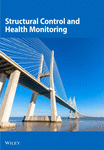Semiactive control strategy for a phase II smart base isolated benchmark building
Abstract
This paper presents a semiactive control strategy for the seismic protection of the phase II smart base isolated benchmark building subjected to near-fault earthquakes. Magnetorheological (MR) fluid dampers controlled by an optimal direct output feedback control algorithm with a voltage generator are used as semiactive control devices. The benchmark building is an eight-story base isolated building, and the superstructure is considered to be a linear elastic system with lateral–torsional behavior. To reduce the energy transmitted to the structure from the ground, a combination of linear and nonlinear bearings is installed at the base of the structure. It is difficult to design the controller for this benchmark problem because of the nonlinear behavior of the isolation members. Linear control theory is frequently applied to nonlinear structures because there are no appropriate and well-defined control theories that can consider general types of nonlinearities. Therefore, to improve control performance, the nonlinearities of the isolation members are considered indirectly with the linear control theory during the design process of the controllers for the MR dampers. Numerical simulation results under various earthquake inputs show that the proposed control strategy is effective in reducing the responses of the isolation members as well as the superstructure. Therefore, the proposed control system could be used as an improved control strategy for base isolated buildings subjected to near-fault earthquakes. Copyright © 2008 John Wiley & Sons, Ltd.




